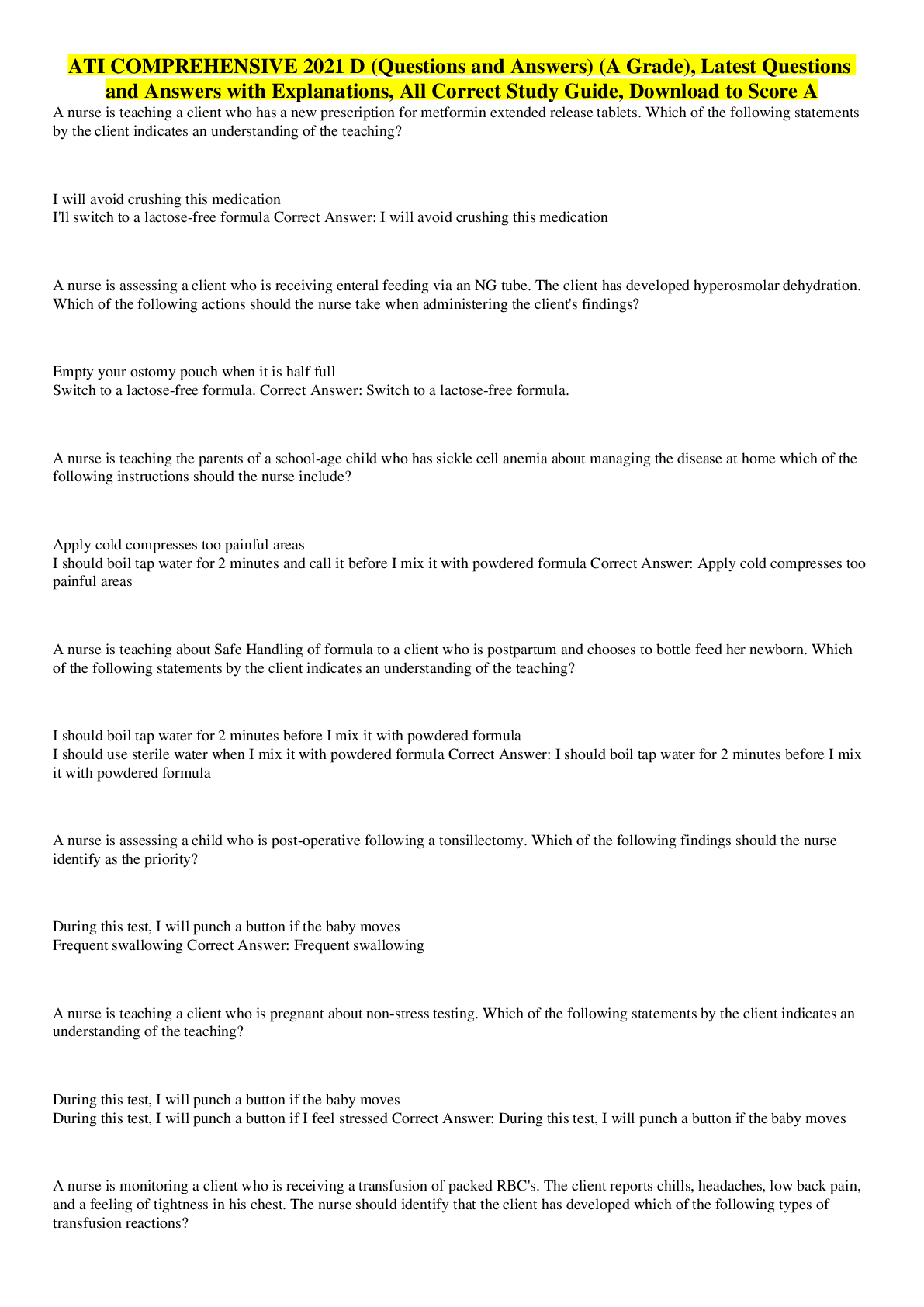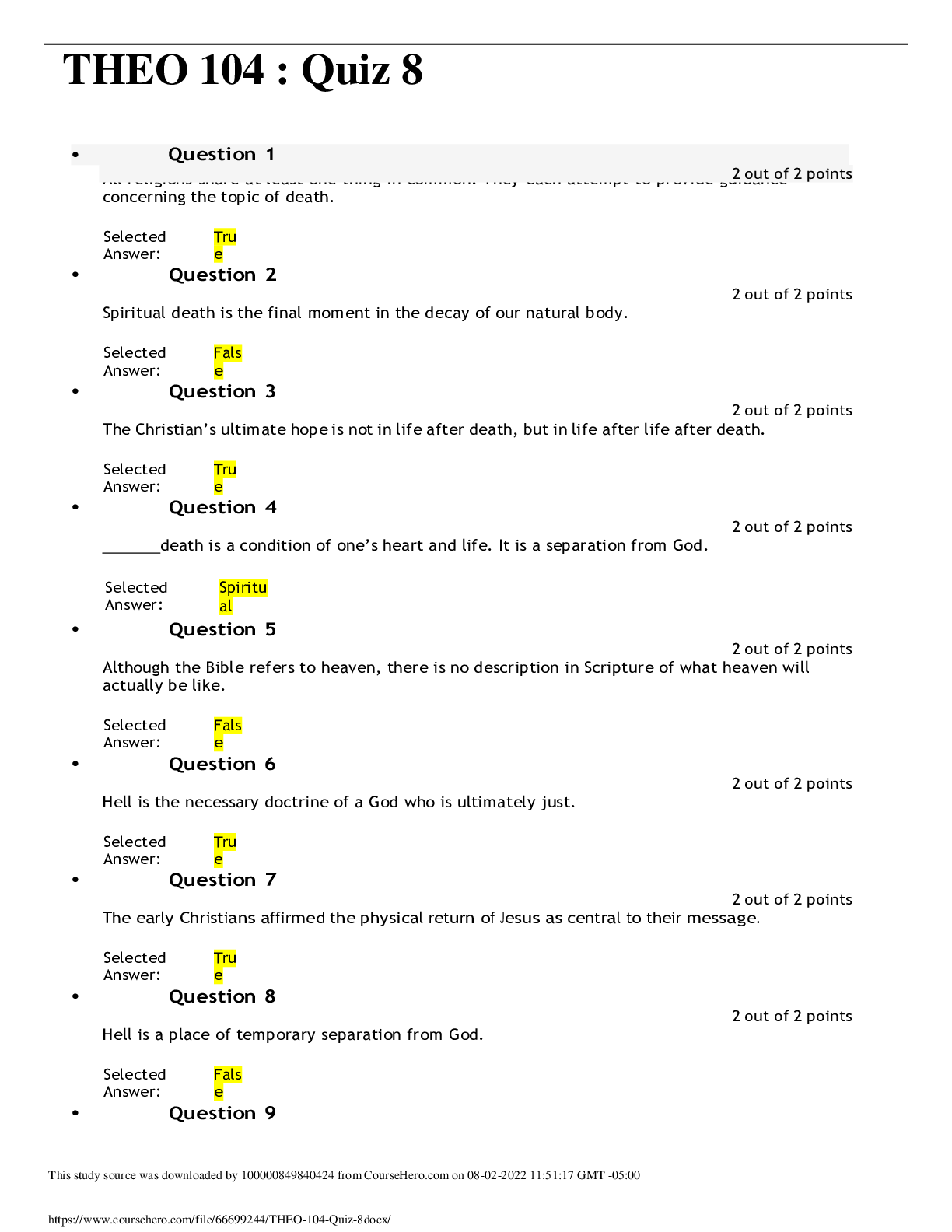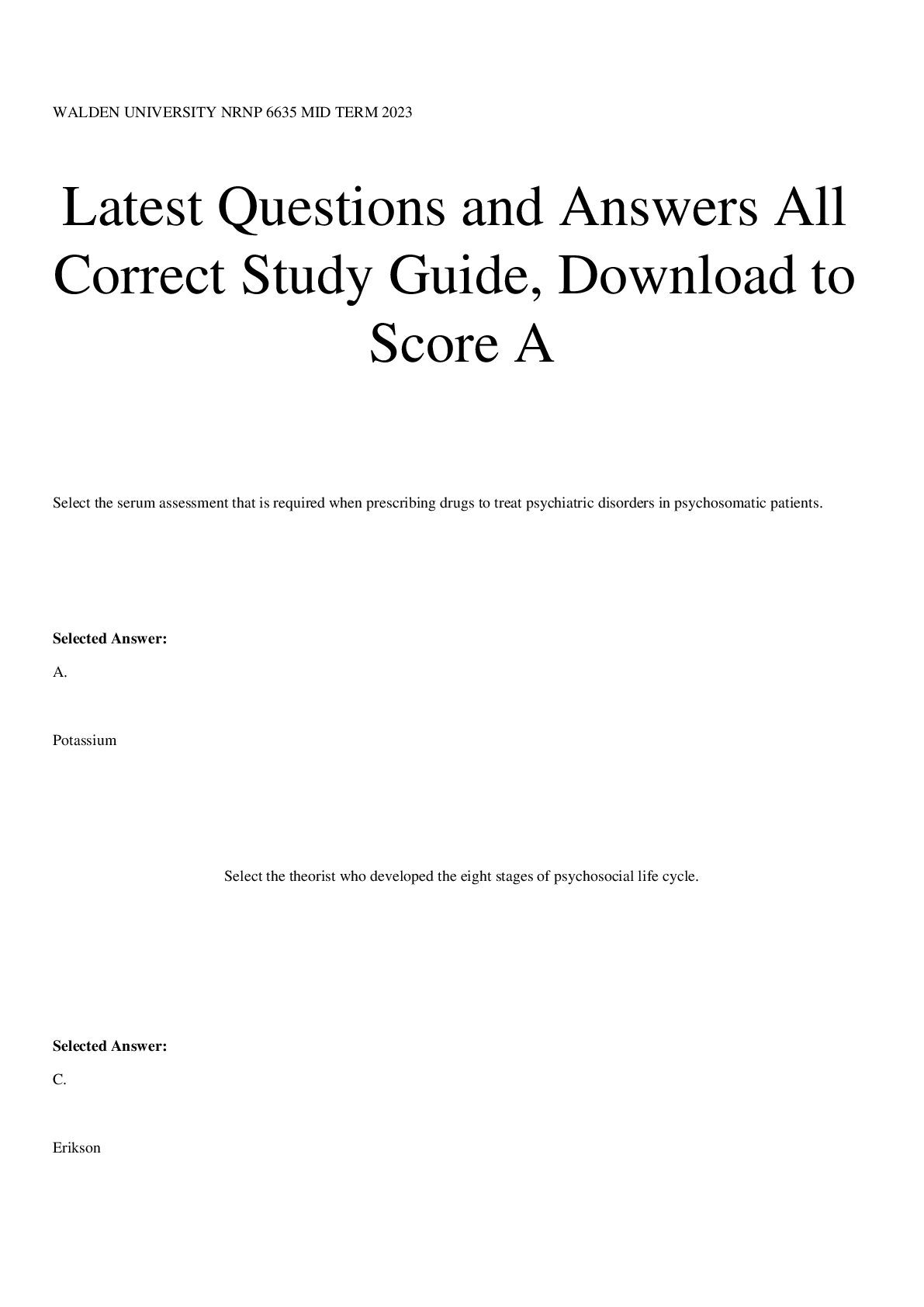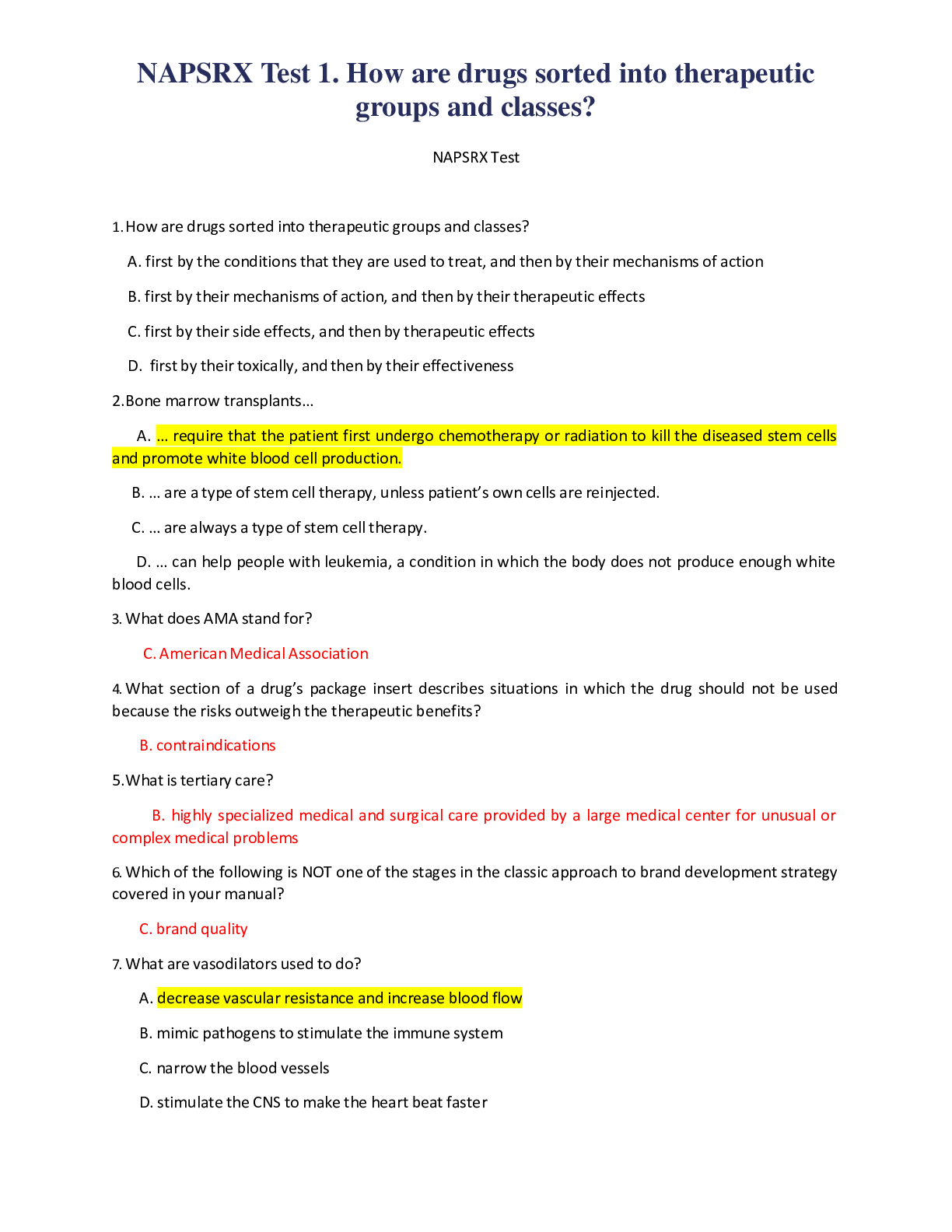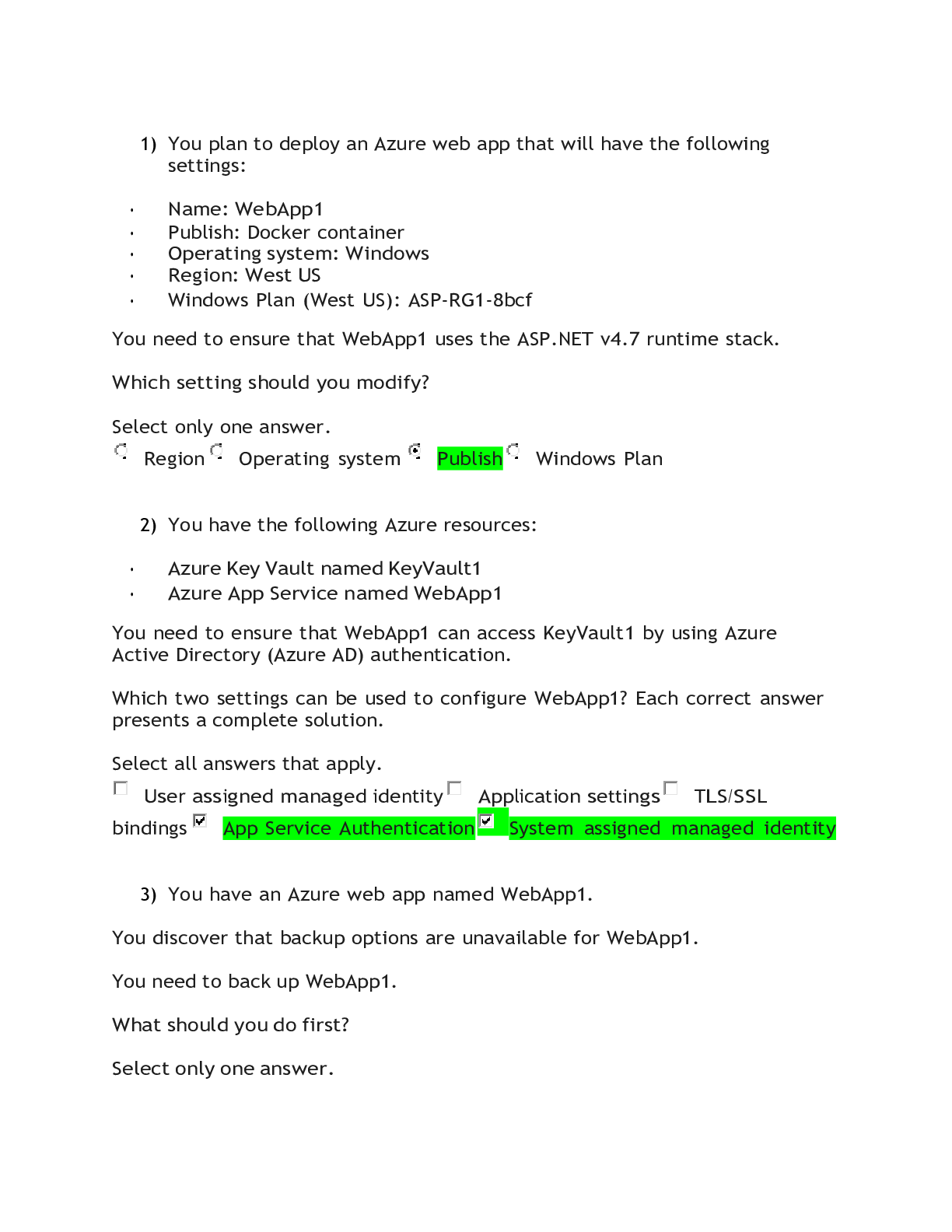*NURSING > EXAM > Walden University NRNP 6531 Midterm Exam 2022 - Latest Questions and Answers | 100% Correct (All)
Walden University NRNP 6531 Midterm Exam 2022 - Latest Questions and Answers | 100% Correct
Document Content and Description Below
Question 2 The most common cancer found on the auricle is: Basal cell carcinoma Question 3 Which of the following medication classes should be avoided in patients with acute or chronic bronchi... tis because it will contribute to ventilation-perfusion mismatch in the patient?: Antihistimines Question 4 A 47 year old male patient presents to the clinic with a single episode of a moderate amount of bright red rectal bleeding. On examination, external hemorrhoids are noted. How should the nurse practitioner proceed?: Refer the patient for a barium enema and sigmoidoscopy. Question 5 Which of the following patient characteristics are associated with chronic bronchitis?: Overweight, cyanosis, and normal or slightly increased respiratory rate Question 6 A 65-year-old female with a past medical history of hypertension, hyperlipidemia, and polymyalgia rheumatica presents to urgent care with new onset left lower quadrant pain. Her current medications include omeprazole 20 milligrams po daily, lisinopril 20 milligrams po daily, simvastatin 20 milligrams po daily, and prednisone 12 milligrams po daily. The nurse practitioner suspects acute diverticulitis and possibly an abscess. The most appropriate diagnostic test for this patient at this time is: CT scan Question 7 A patient reports “something flew in my eye” about an hour ago while he was splitting logs. If there were a foreign body in his eye, the nurse practitioner would expect to find all except: Purulent drainage Question 8 A 21 year old college student presents to the student health center with copious, markedly purulent discharge from her left eye. The nurse practitioner student should suspect: Gonococcal conjunctivitis Question 9 A 35 year old man presents with radicular pain followed by the appearance of grouped vesicles consisting of about 15 lesions across 3 different thoracic dermatomes. He complains of pain, burning, and itching. The nurse practitioner should suspect: Herpes zoster and consider that this patient may be immunocompromised Question 10 Which type of lung cancer has the poorest prognosis?: Small cell carcinoma Question 11 An 83-year-old female presents to the office complaining of diarrhea for several days. She explains she has even had fecal incontinence one time. She describes loose stools 3–4 times a day for several weeks and denies fever, chills, pain, recent antibiotic use. The history suggests that the patient has: Chronic diarrhea Question 12 Margaret, age 32, comes into the office with painful joints and a distinctive rash in a butterfly distribution on her face. The rash has red papules and plaques with a fine scale. What do you suspect?: Systemic lupus erythematosus Question 13 Antibiotic administration has been demonstrated to be of little benefit to the treatment of which of the following disease processes?: Acute bronchitis Question 14 Lisa, age 49, has daily symptoms of asthma. She uses her inhaled short-acting beta-2 agonist daily. Her exacerbations affect her activities and they occur at least twice weekly and may last for days. She is affected more than once weekly during the night with an exacerbation. Which category of asthma severity is Lisa in?: Moderate persistent Question 15 Which of the following is the most appropriate therapeutic regimen for an adult patient with no known allergies diagnosed with group A B-hemolytic strep?: Penicillin V 500 milligrams PO every 8 hours for 10 days Question 16 A cashier complains of dull ache and pressure sensation in her lower legs. It is relieved by leg elevation. She occasionally has edema in her lower legs at the end of the day. What is the most likely cause of these problems?: Varicose veins Question 17 Which statement below is correct about pertussis?: It is also called whooping cough Question 18 Which of the following is the most important diagnosis to rule out in the adult patient with acute bronchitis?: Pneumonia Question 19 A 70 year old patient presents with left lower quadrant (LLQ) abdominal pain, a markedly tender palpable abdominal wall, fever, and leukocytosis. Of the following terms, which correctly describes the suspected condition?: Diverticulitis Question 20 Sylvia, age 83, presents with a 3 day history of pain and burning in the left forehead. This morning she noticed a rash with erythematous papules in that site. What do you suspect?: Herpes zoster Question 21 A 33-year-old female is admitted with acute pancreatitis. The nurse practitioner knows that the most common cause of pancreatitis is: Gallstones Question 22 1 out of 1 points When a patient presents with symptoms of acute gallbladder disease, what is the appropriate nurse practitioner action?: Order an abdominal ultrasound Question 23 A false-positive result with the fecal occult blood test can result from: a high dietary intake of rare cooked beef Question 24 A 76-year-old male complains of weight loss, nausea, vomiting, abdominal cramping and pain. Physical findings include an abdominal mass and stool positive for occult blood. The nurse practitioner pain suspects a tumor in the small intestine. The best diagnostic test for this patient is: Small bowel follow-through Question 25 A patient presents to urgent care complaining of dyspnea, fatigue, and lower extremity edema. The echocardiogram reveals and ejection fraction of 38%. The nurse practitioner knows that these findings are consistent with: Systolic heart failure Question 26 Maxine, Age 76, has just been given a diagnosis of pneumonia. Which of the following is an indication that she should be hospitalized? : Multilobar involvement on chest x-ray with the inability to take oral medications Question 27 A 55 year old man is diagnosed with basal cell carcinoma. The nurse practitioner correctly tells him: “It can be cured with surgical excision or radiation therapy.” Question 28 Expected spirometry readings when the patient has chronic emphysema include: Increased total lung capacity (TLC) Question 29 1 out of 1 points An 80-year-old male admits to difficulty swallowing during the review of systems. The nurse practitioner recognizes the differential diagnosis for this patient’s dysphagia is: Esophageal cancer, GERD. A and C Question 30 A 40 year old female with history of frequent sun exposure presents with a multicolored lesion on her back. It has irregular borders and is about 11mm in diameter. What should the nurse practitioner suspect?: Malignant [Show More]
Last updated: 1 year ago
Preview 1 out of 16 pages
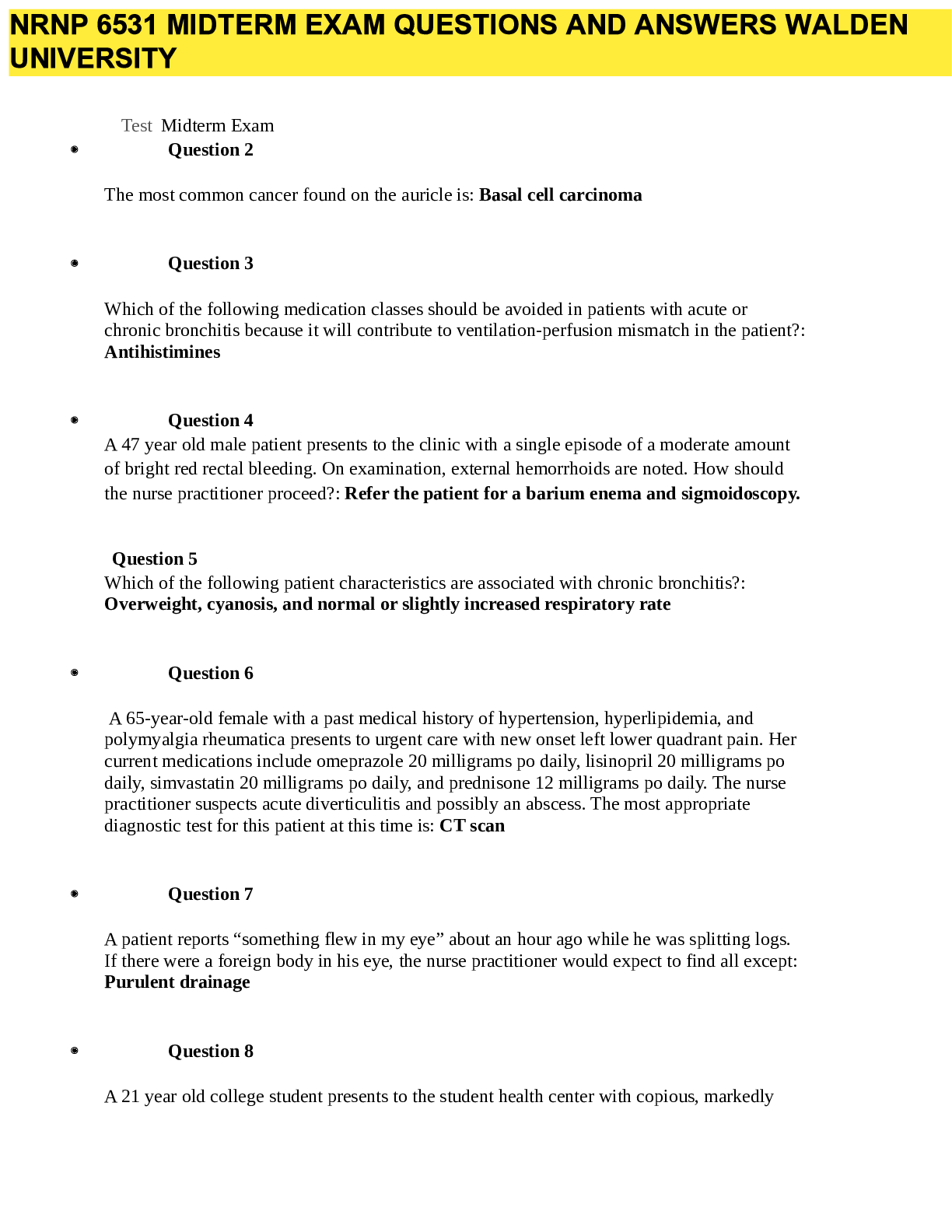
Reviews( 0 )
Document information
Connected school, study & course
About the document
Uploaded On
Jun 28, 2022
Number of pages
16
Written in
Additional information
This document has been written for:
Uploaded
Jun 28, 2022
Downloads
0
Views
37

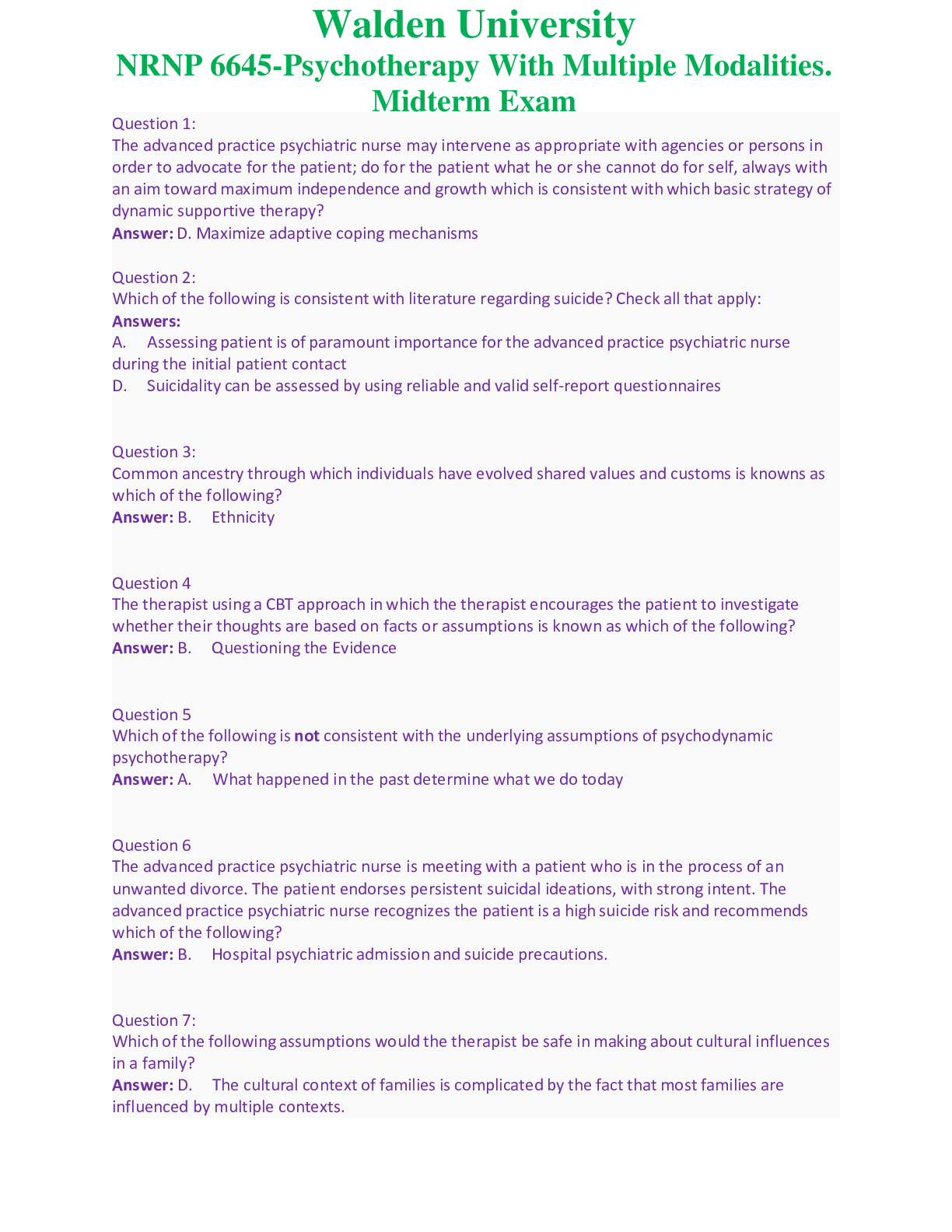

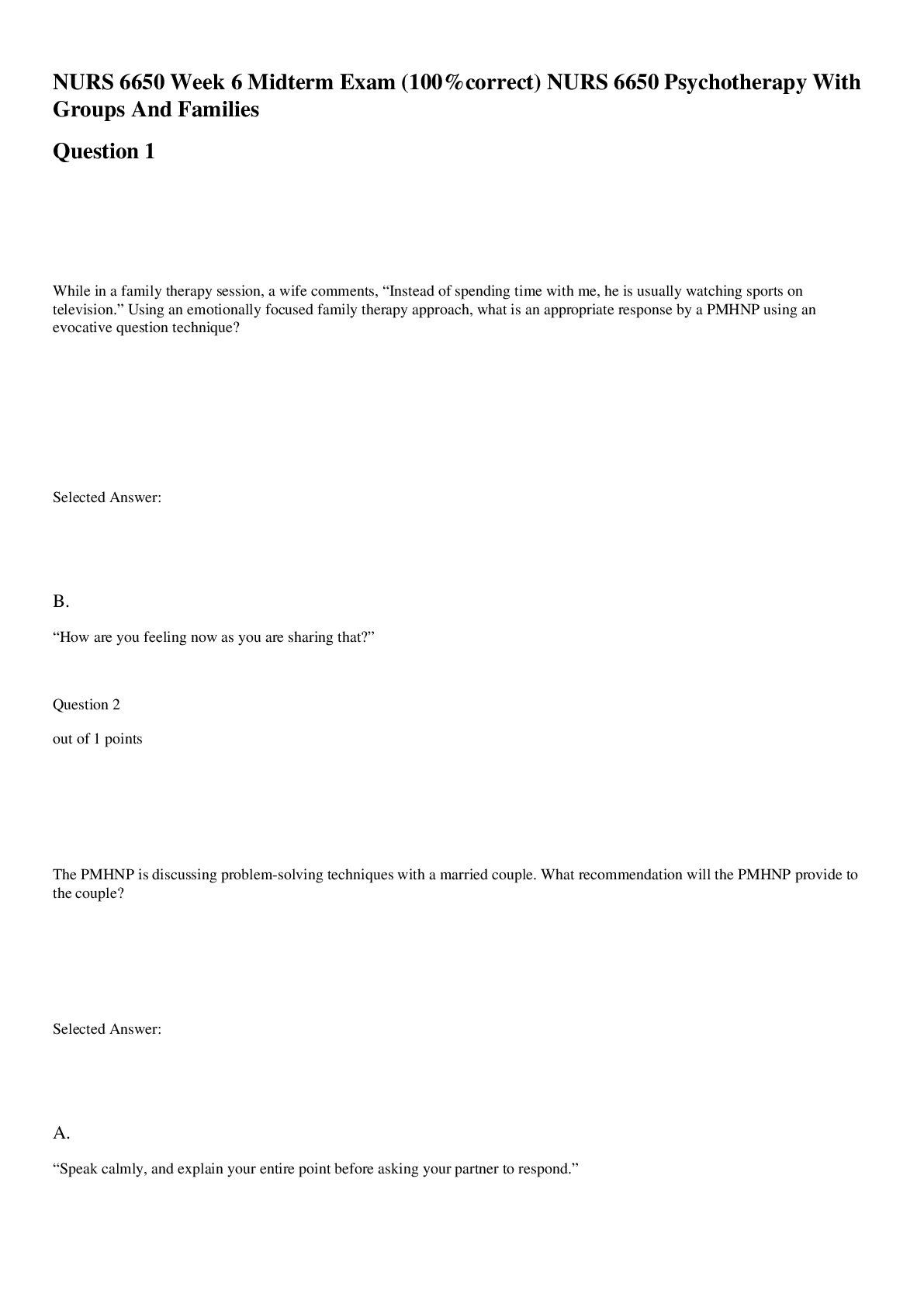
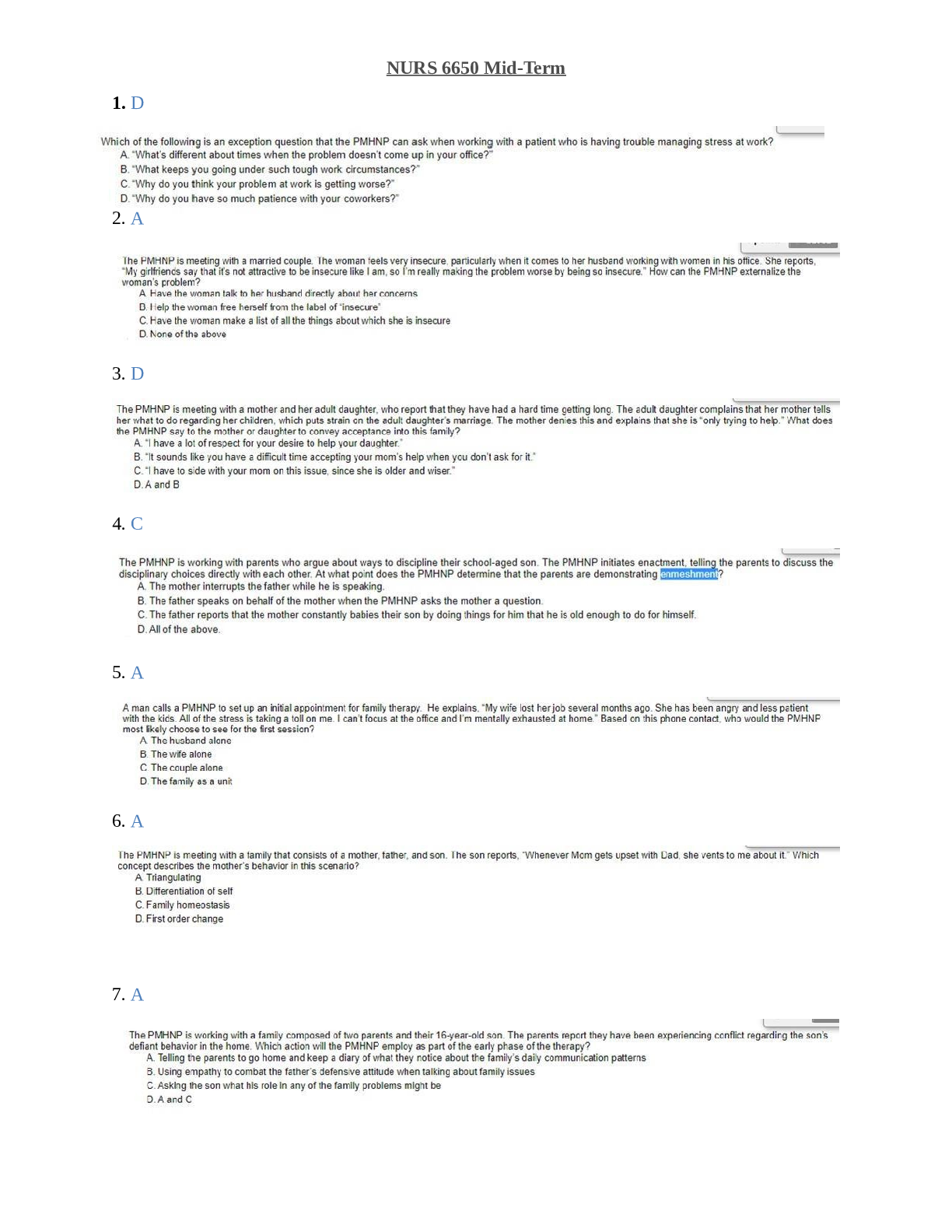
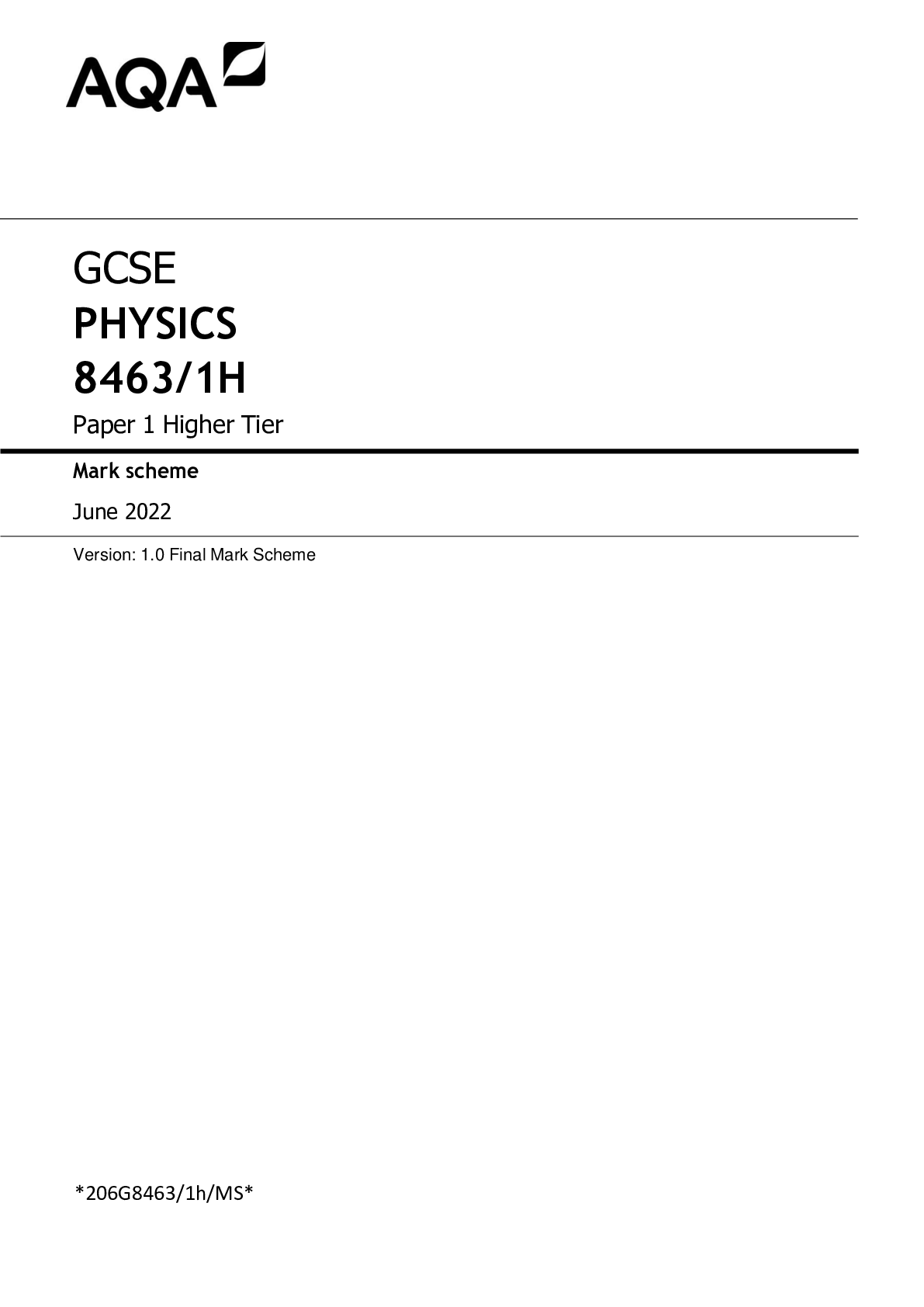

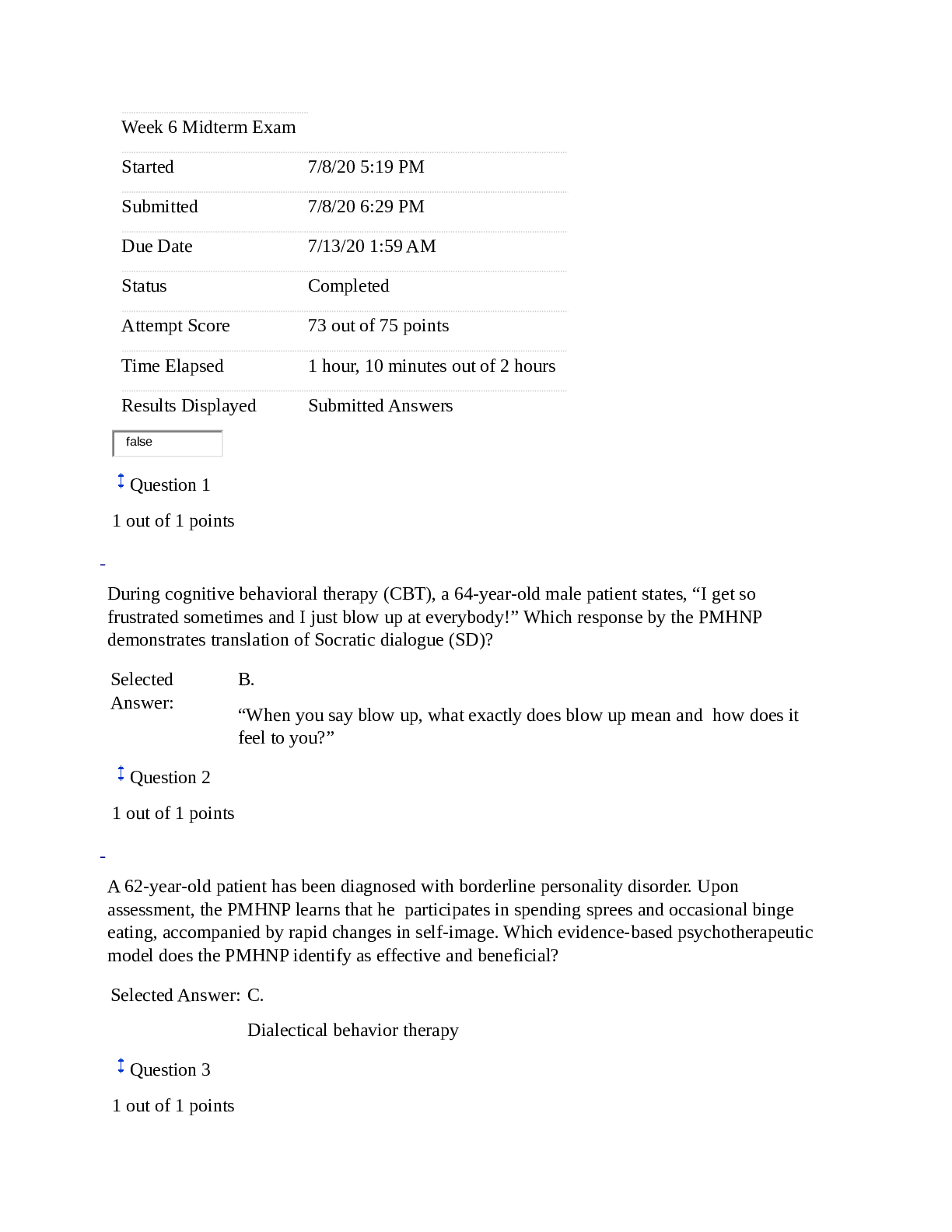
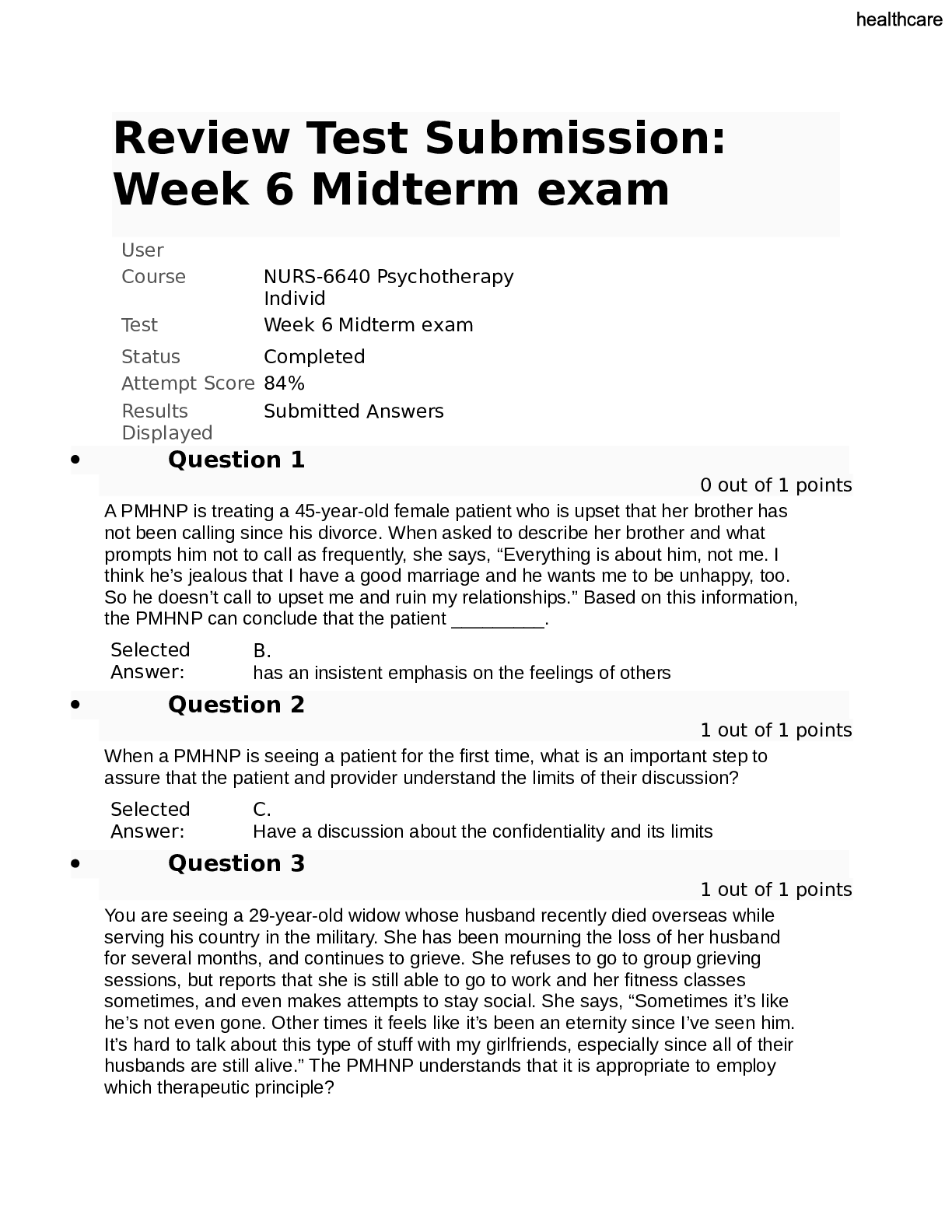
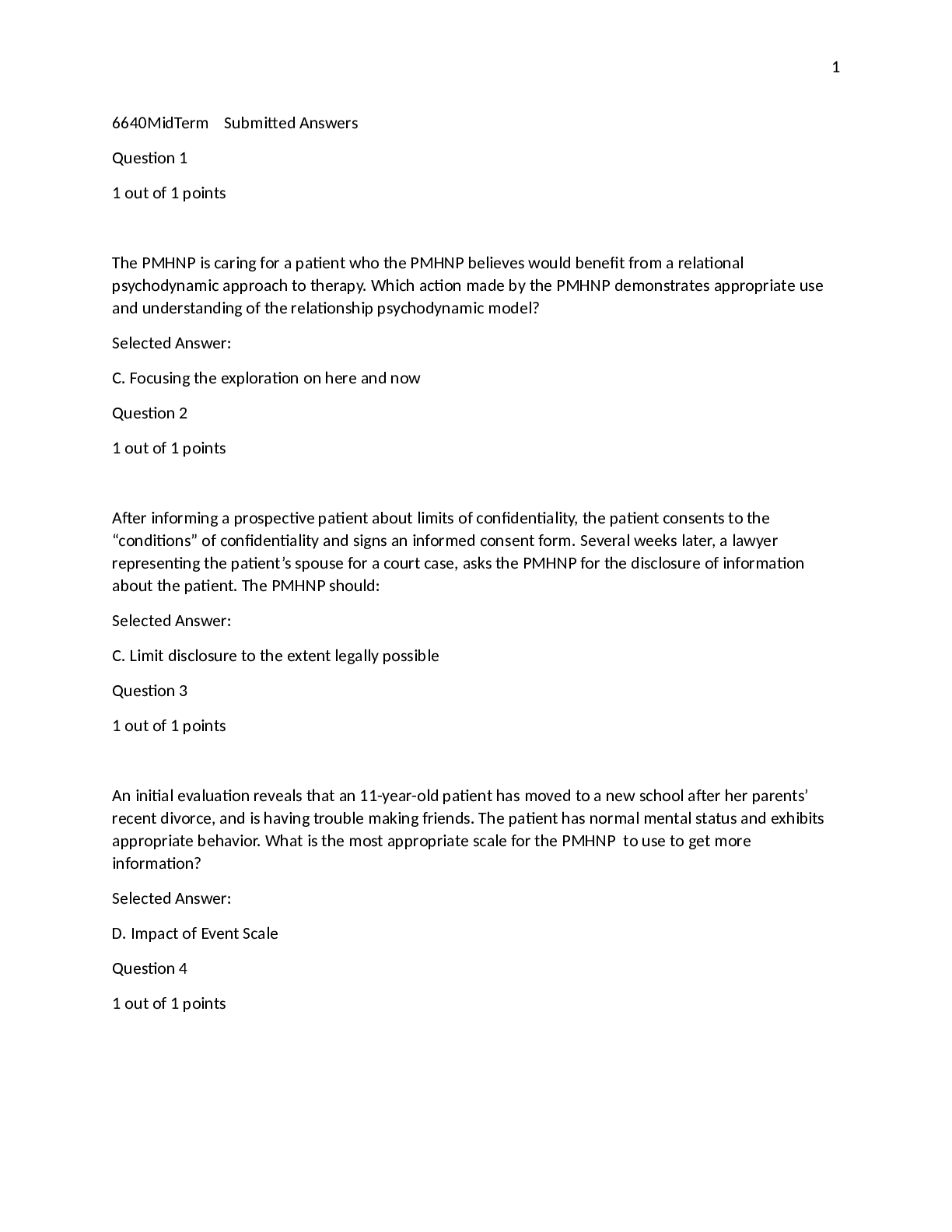

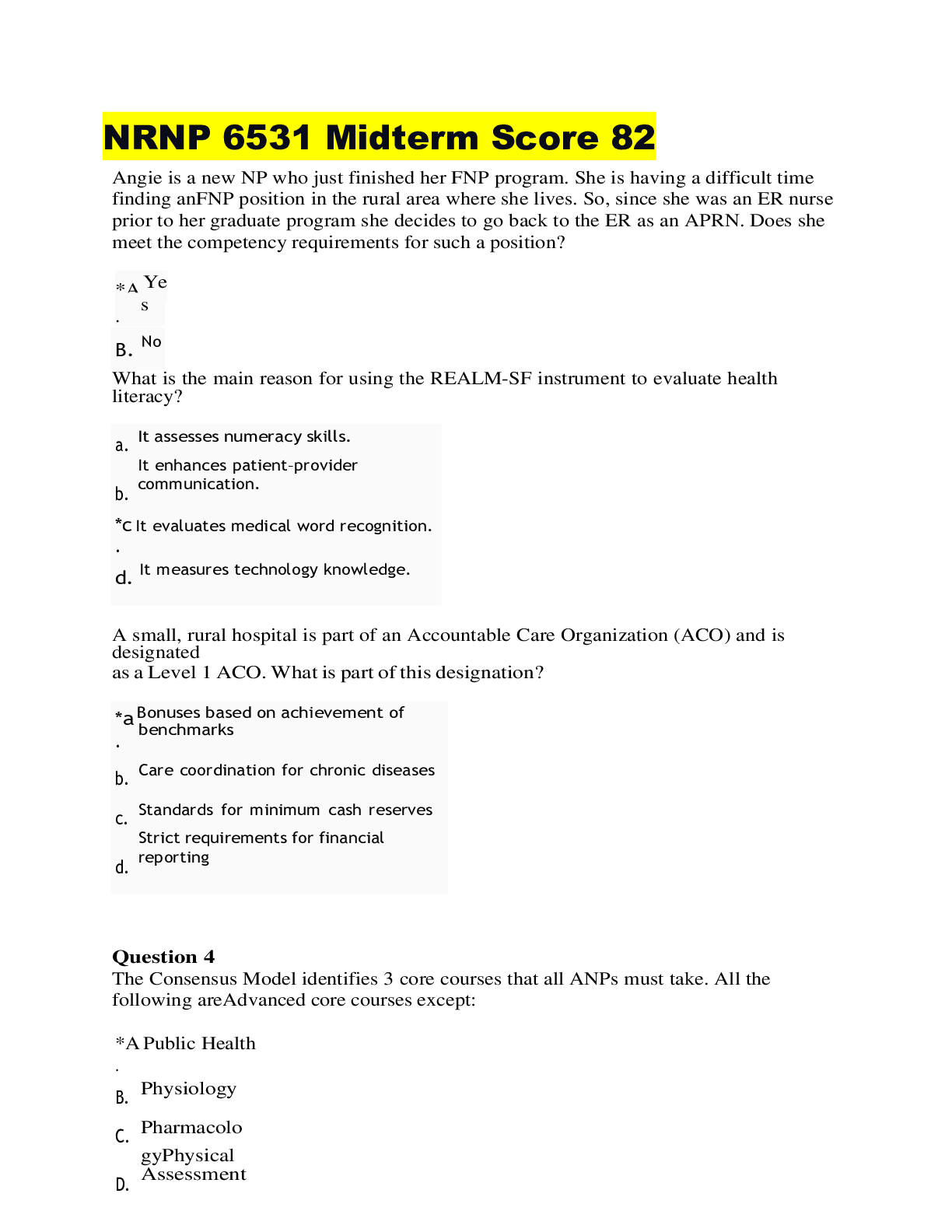
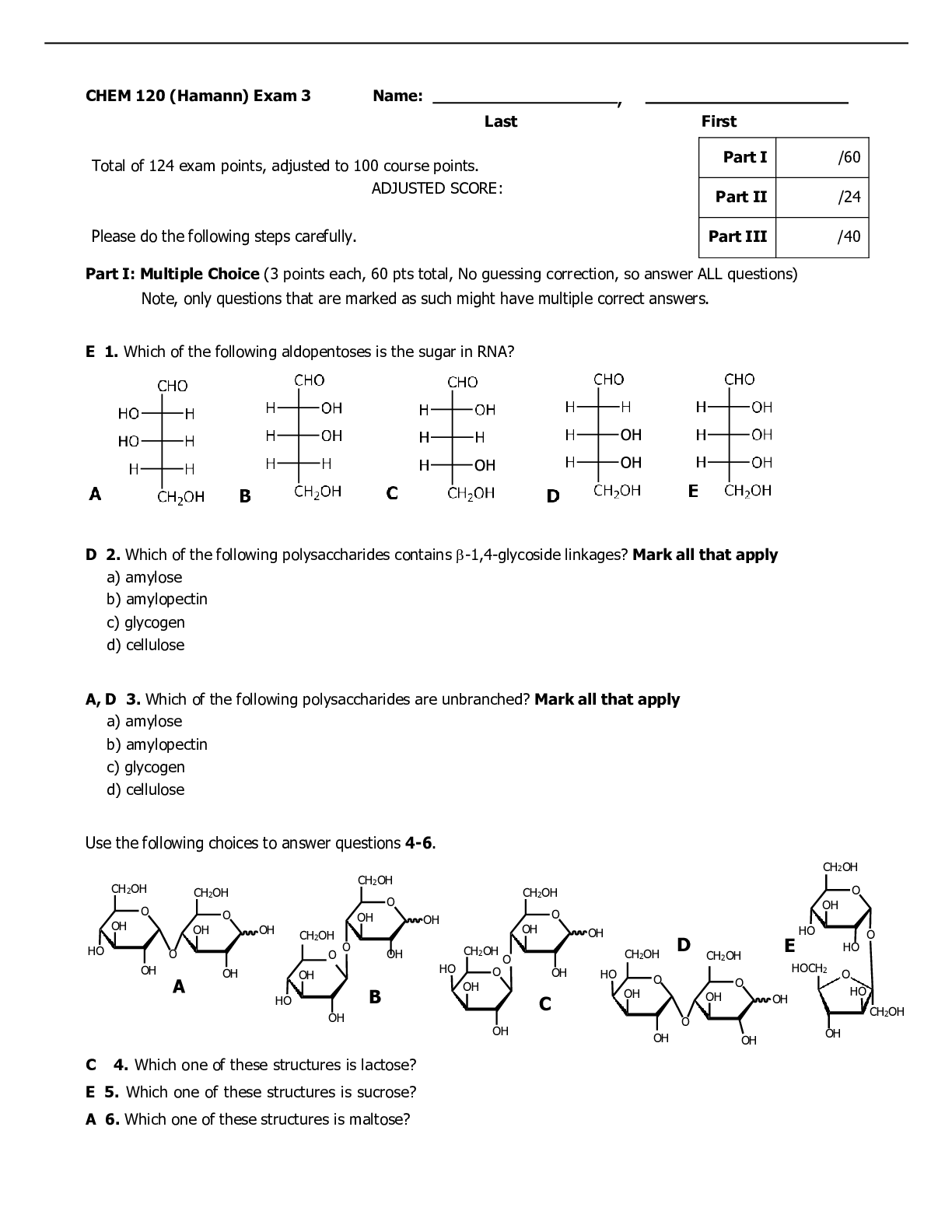
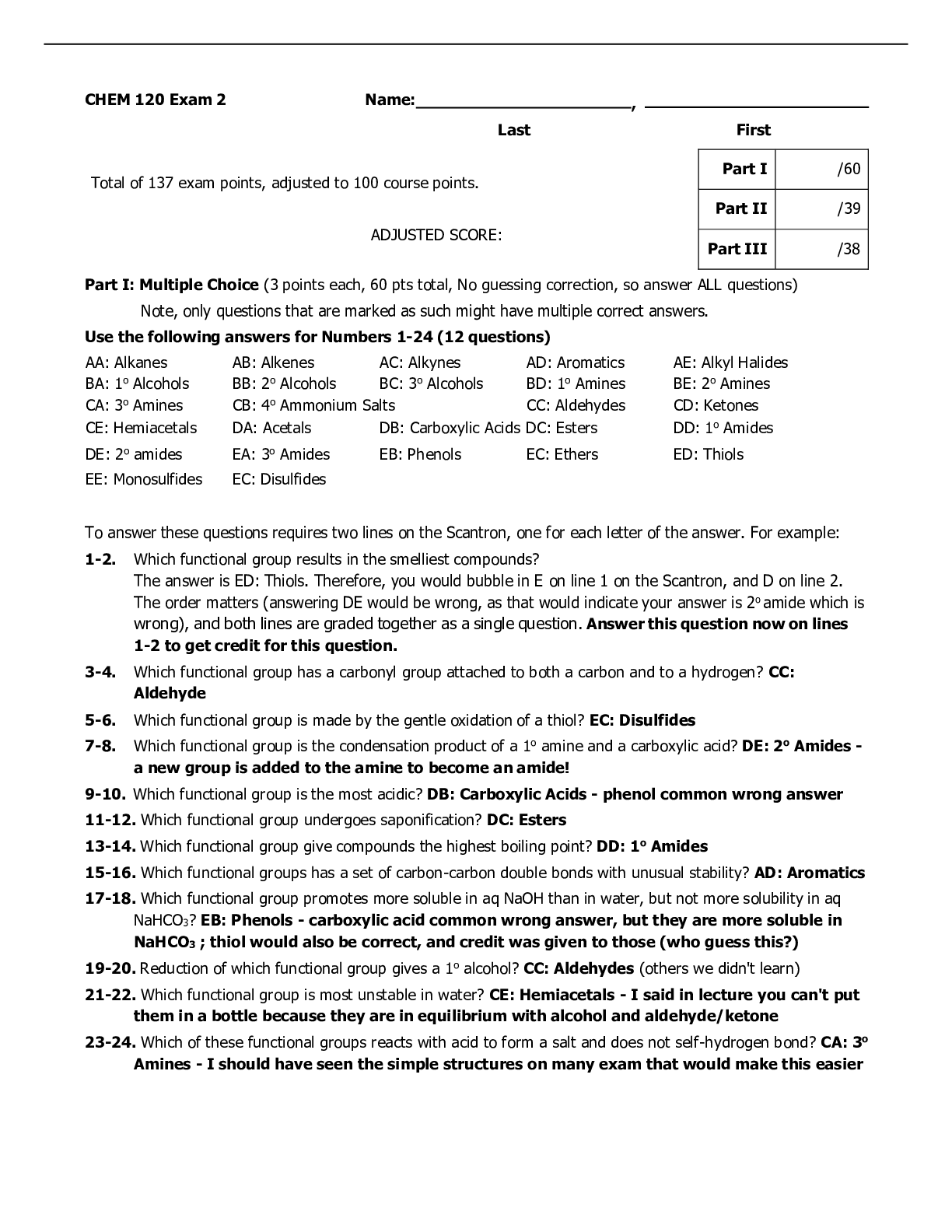
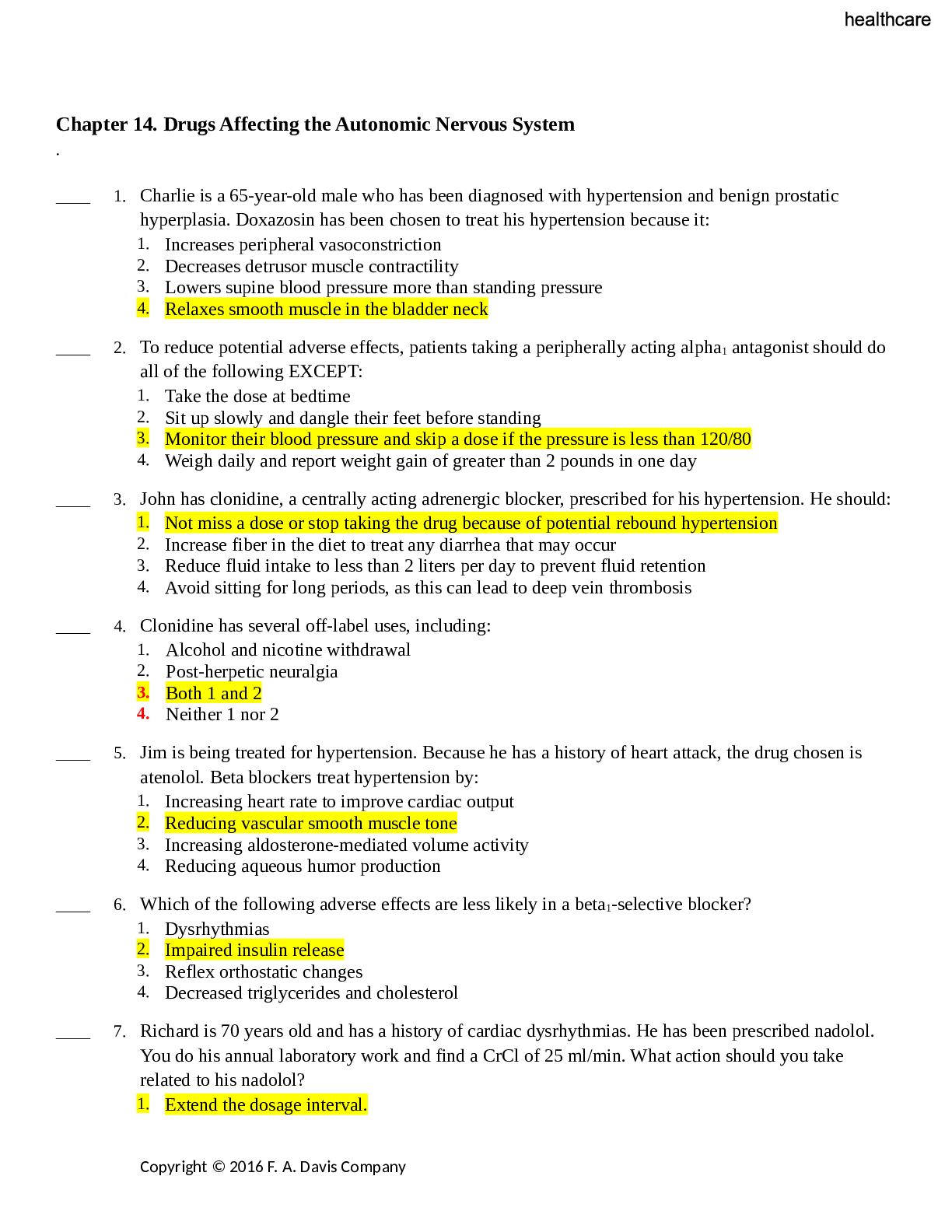
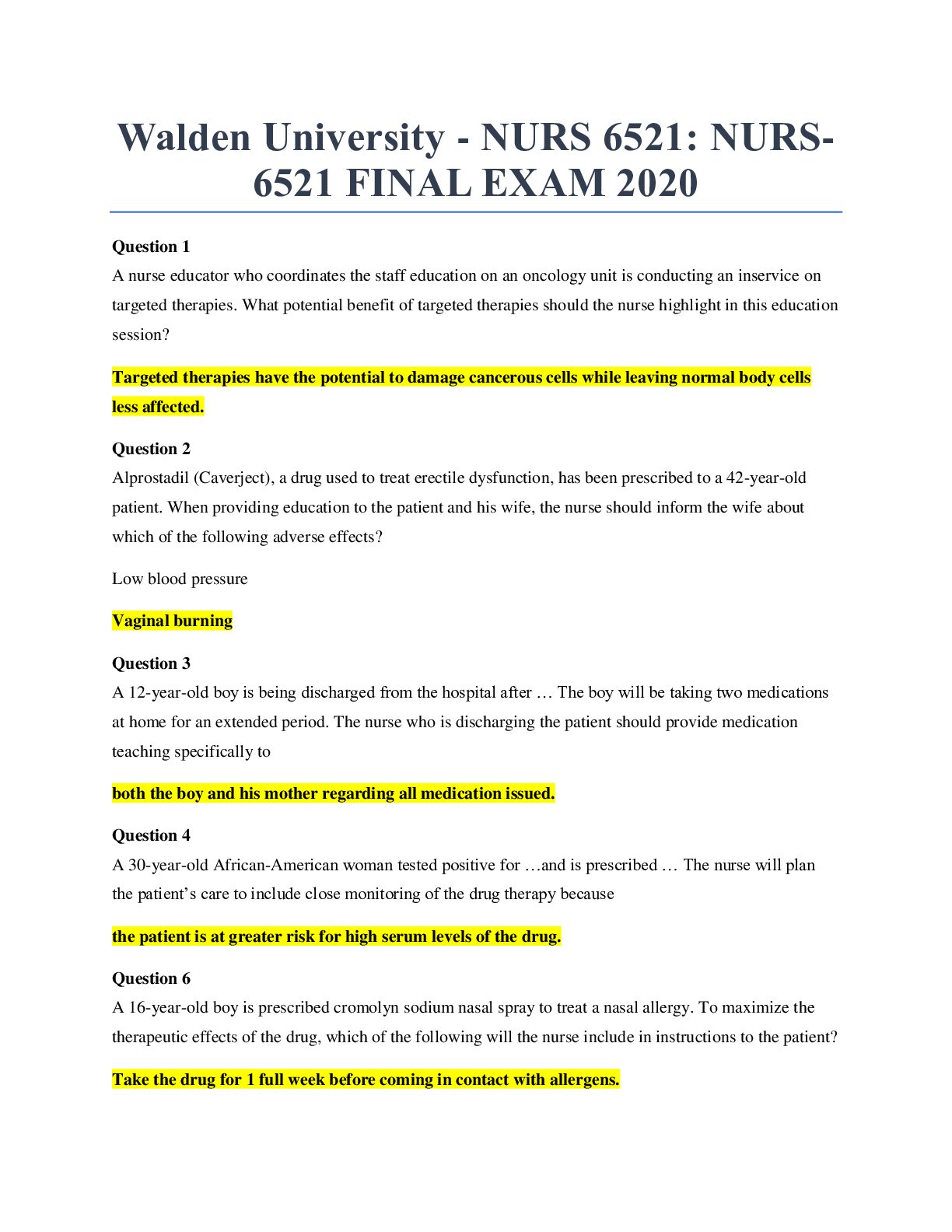
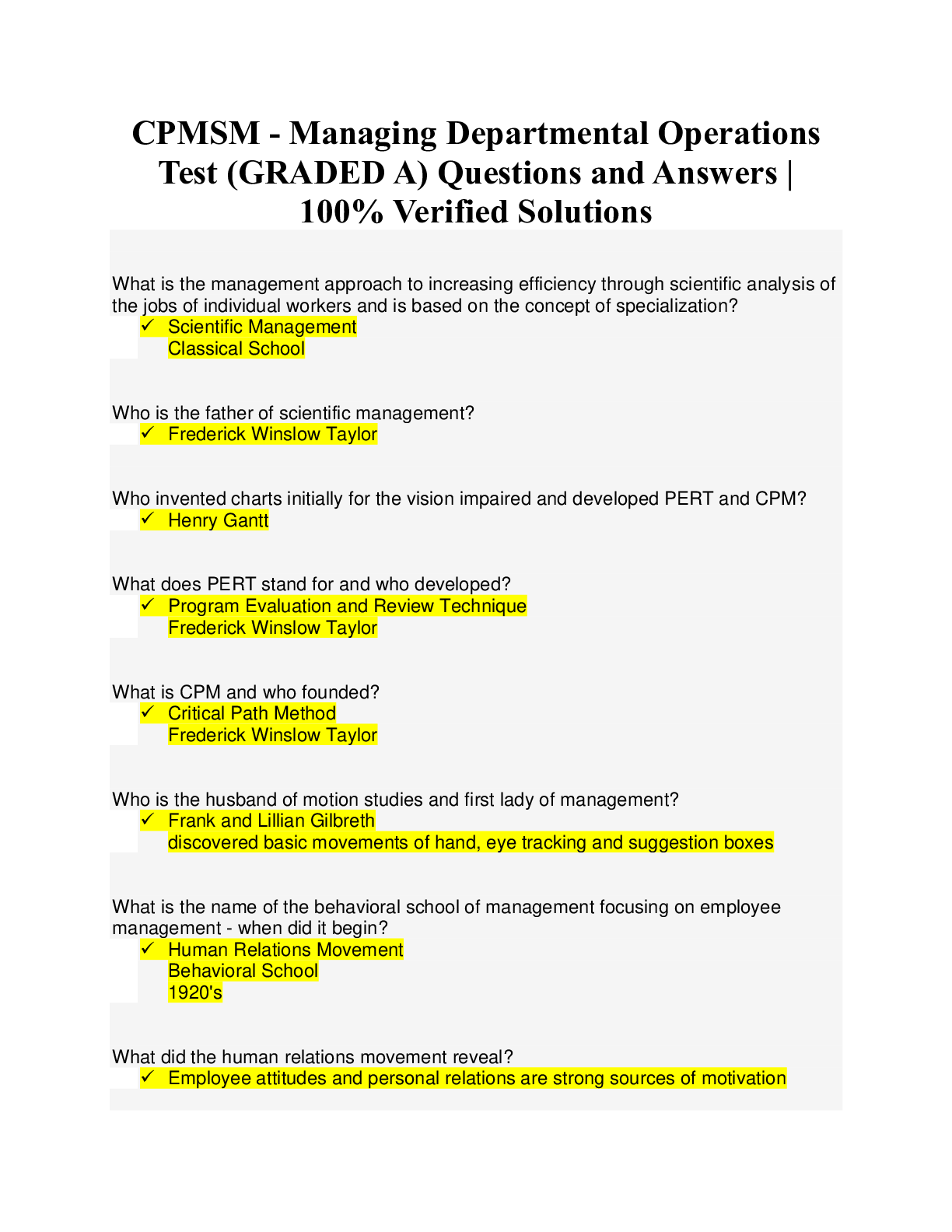

.png)
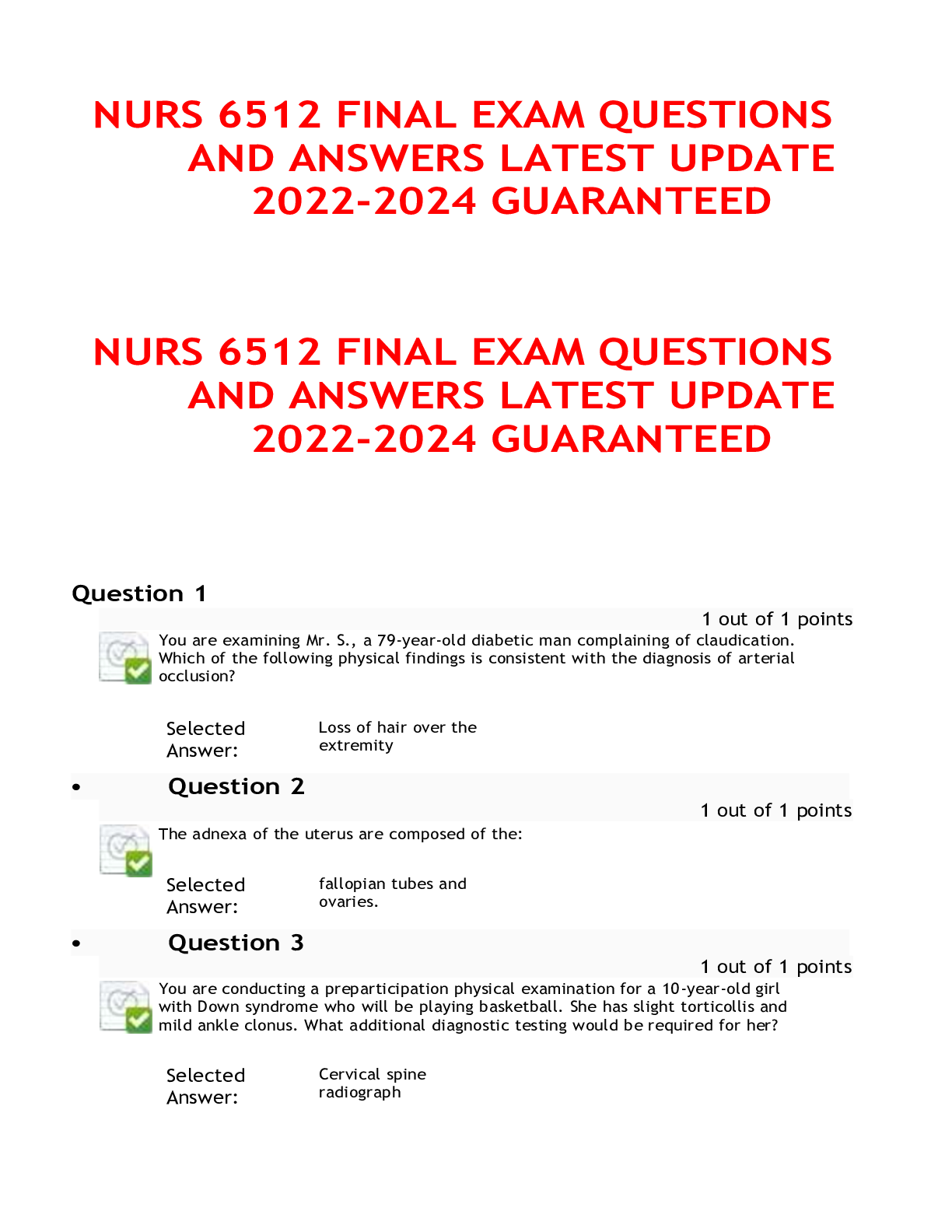

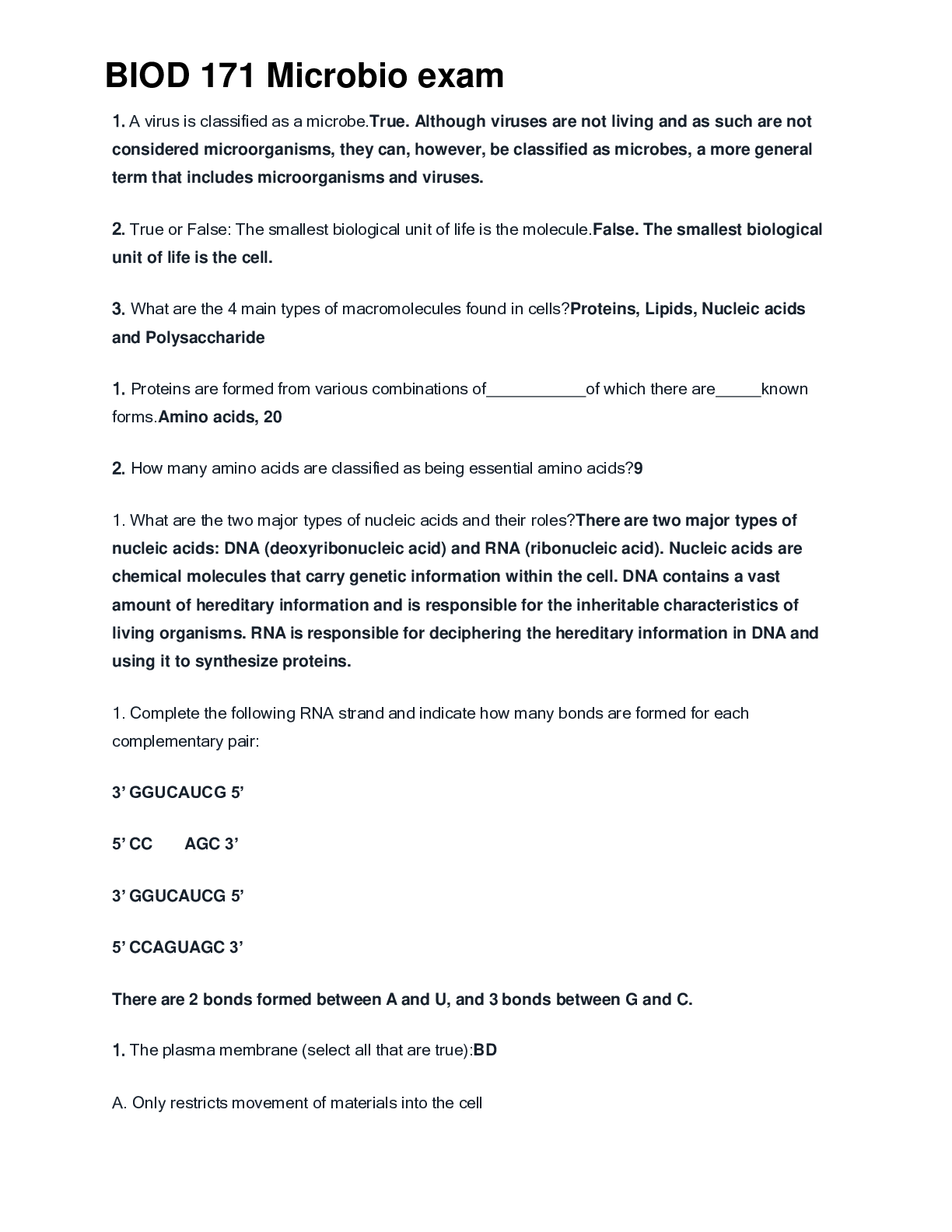
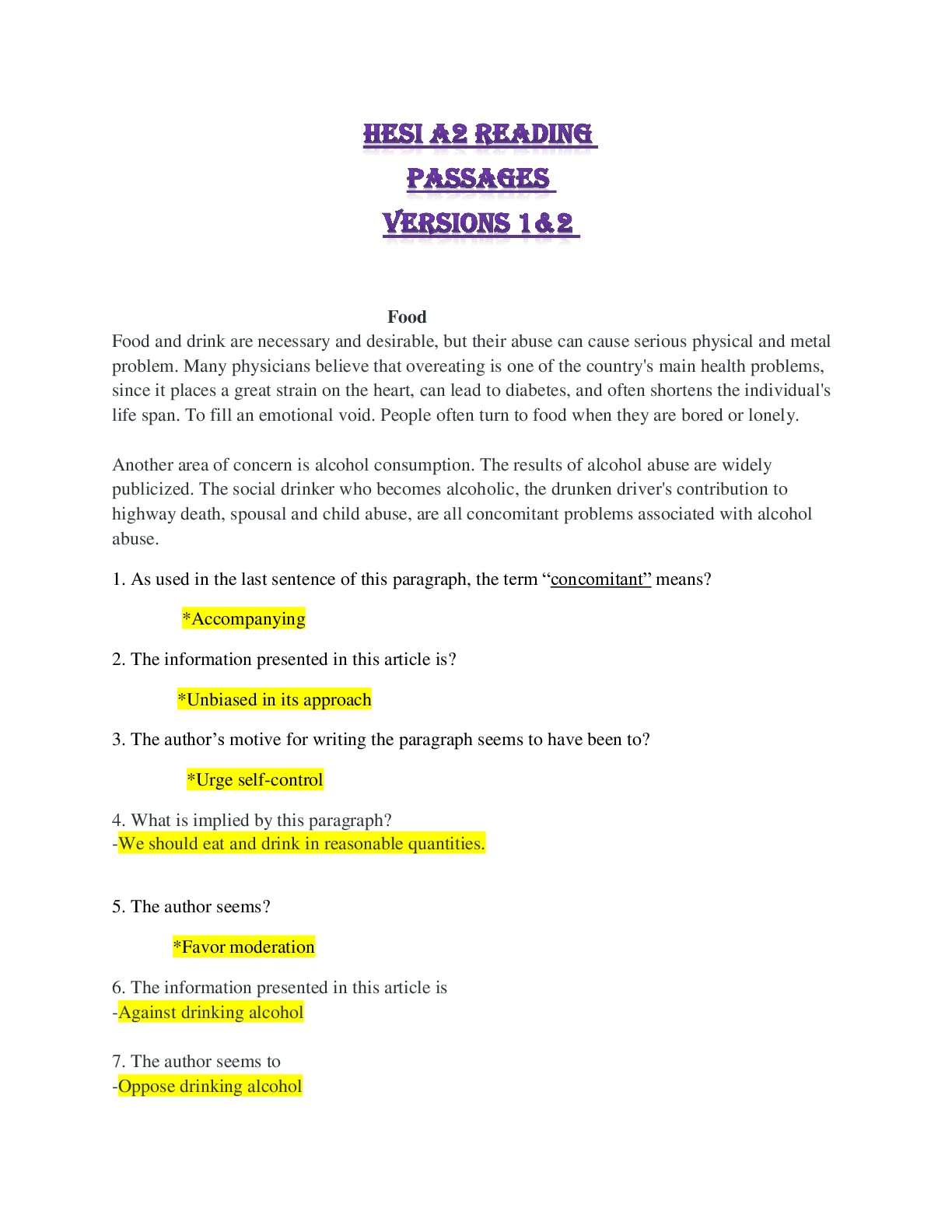

 (1).png)

